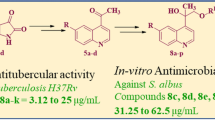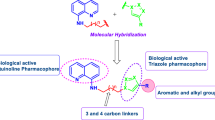Abstract
The increasing microbial resistance to primary active structures remains alarming and the effort to look for new antibacterial active structures is still of scientific interest. One of the attractive ways to find new active structures is derivatization of well-known natural compounds. Alkaloids are a structurally diverse group of natural products with a wide range of biological effects. Historically, an attempt to increase the antimicrobial activity of alkaloids through chemical modifications has been successful. In this work, 12 new quinolizidine derivatives were synthesized and tested for their antimicrobial activity. The asymmetric synthesis of the benzoanalogue of the phenanthroquinolizidine bioactive alkaloid (−)-cryptopleurine and the epi-benzoanalogues of (−)-(15R)-hydroxycryptopleurine were achieved in six or seven steps starting from available enantiopure (S)-2-aminoadipic acid used as source of chirality as well as nitrogen. The highest antimicrobial activity was observed in the presence of the final saturated structure, the benzoanalogue of naturally occurring plant alkaloid cryptopleurine. It features selective toxicity, and significantly inhibits the growth of G+ bacteria, especially Staphylococcus sp. Tested derivatives have shown only a weak antifungal activity, but partial inhibition has been observed in the case of model yeasts.
Graphical abstract





Similar content being viewed by others
References
Laxminarayan R, Duse A, Wattal C, Zaidi AK, Wertheim HF, Sumpradit N, Vlieghe E, Hara GL, Gould IM, Goossens H, Greko C, So AD, Bigdeli M, Tomson G, Woodhouse W, Ombaka E, Peralta AQ, Qamar FN, Mir F, Kariuki S, Bhutta ZA, Coates A, Bergstrom R, Wright GD, Brown ED, Cars O (2013) Lancet Infect Dis 13:1057
Gundersen LL, Charnock C, Negussie AH, Rise F, Teklu S (2007) Eur J Pharm Sci 30:26
Cushnie TT, Cushnie B, Lamb AJ (2014) Int J Antimicrob Agents 44:377
Bunsupa S, Yamazaki M, Saito K (2012) Front Plant Sci 3:239
Kubo H, Kobayashi J, Higashiyama K, Kamei J, Fujii Y, Ohmiya S (2000) Biol Pharm Bull 23:1114
Guarna A, Occhiato EG, Machetti F, Trabocchi A, Scarpi D, Danza G, Comerci A, Serio M (2001) Bioorg Med Chem 9:1385
Vrábel V, Sivy J, Šafař P, Marchalín Š (2016) Acta Chim Slov 9:180
Facchini PJ (2001) Annu Rev Plant Physiol Plant Mol Biol 52:29
Han R, Takahashi H, Nakamura M, Bunsupa S, Yoshimoto N, Yamamoto H, Saito K (2015) Bull Biol Pharm 38:87
Huang W, Kim SJ, Liu J, Zhang W (2015) Org Lett 17:5344
Santhosh RS, Suriyanarayanan B (2014) Planta Med 80:9
Wahba AE, Peng J, Kudrimoti S, Tekwani BL, Hamann MT (2009) Bioorg Med Chem 17:7775
Locher HH, Ritz D, Pfaff P, Gaertner M, Knezevic A, Sabato D, Schroeder S, Barbaras D, Gademann K (2010) Chemotherapy 56:318
Kumar NS, Dullaghan EM, Finlay BB, Gong H, Reiner NE, Selvam JJP, Zoraghi R (2014) Bioorg Med Chem 22:1708
Sivý J, Vrábel V, Marchalín Š, Šafář P (2015) Asian J Chem 27:2635
Šafář P, Marchalín Š, Šoral M, Moncol J, Daïch A (2017) Org Lett 19:4742
Marchalín Š, Szemes F, Bar N, Decroix B (1999) Heterocycles 50:445
Šafář P, Žúžiová J, Bobošikova M, Marchalín Š, Prónayová N, Comesse S (2009) Tetrahedron Asymmetry 20:2137
Šafář P, Žúžiová J, Marchalín Š, Tóthova E, Prónayová N, Švorc Ľ, Vrábel V, Daïch A (2009) Tetrahedron Asymmetry 20:626
Šafář P, Marchalín Š, Prónayová N, Vrábel V, Lawson AM, Othman M, Daich A (2016) Tetrahedron 72:3221
Rasmussen MO, Delair P, Greene AE (2001) J Org Chem 66:5438
Rao KN, Venkatachalam SR (2000) Toxicol In Vitro 14:53
Rao KN (1998) Indian J Biochem Biophys 35:229
Zakrzewski SF (1963) J Biol Chem 238:1485
Baker DJ, Beddell CR, Champness JN, Goodford PJ, Norrington FEA, Smith DR, Stammers DK (1981) FEBS Lett 126:49
Markowitz N, Quinn EL, Saravolatz LD (1992) Ann Intern Med 117:390
García D, Foubelo F, Yus M (2010) Eur J Org Chem 2010:2893
Yamada S, Kunieda T (1967) Chem Pharm Bull 15:490
Sheldrick GM (2015) Acta Cryst A71:3
Hübschle CB, Sheldrick GM, Dittrich B (2011) Appl Cryst 44:1281
Dolomanov OV, Bourhis LJ, Gildea RJ, Howard JAK, Puschmann HJ (2009) Appl Cryst 42:339
Brandenburg K (1999) DIAMOND. Crystal Impact GbR, Bonn
Clinical and Laboratory Standards Institute (CLSI) (1996) Reference method for broth dilution antifungal susceptibility testing yeast; approved standard. USA
Clinical and Laboratory Standards Institute (CLSI) (2014) Methods for dilution antimicrobial susceptibility tests for bacteria that grow aerobically; NCCLS document M27-A, 15, 10, VA Medical Center, Tucson; Approved standard, 8th edn. CLSI M7-A9, USA
Dudová B, Hudecová D, Pokorný R, Mikulášová M, Palicová M, Segľa P, Melník M (2002) Folia Microbiol 47:225
Taniguchi L, de Fátima Faria B, Rosa RT, de Paula e Carvalho A, Gursky LC, Elifio-Esposito SL, Parahitiyawa N, Samaranayake LP, Rosa EAR (2009) J Microbiol Methods 78:171
Maron D, Ames B (1983) Mut Res 113:173
Acknowledgements
This work was supported by the Grant Agency of the Slovak Republic (Grant no. 1/0371/16). This contribution is also the result of the project: Research Center for Industrial Synthesis of Drugs, ITMS 26240220061, supported by the Research & Development Operational Programme funded by the ERDF.
Author information
Authors and Affiliations
Corresponding author
Electronic supplementary material
Below is the link to the electronic supplementary material.
Rights and permissions
About this article
Cite this article
Pagáč, T., Šafář, P., Marchalín, Š. et al. Asymmetric synthesis and study of biological activity of (epi-)benzoanalogues of bioactive phenanthroquinolizidine alkaloids. Monatsh Chem 149, 1865–1876 (2018). https://doi.org/10.1007/s00706-018-2244-5
Received:
Accepted:
Published:
Issue Date:
DOI: https://doi.org/10.1007/s00706-018-2244-5




